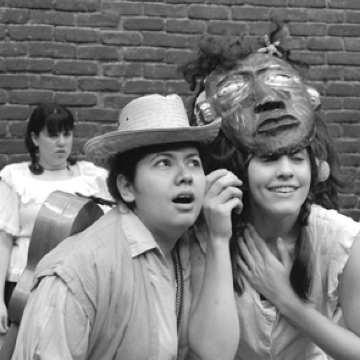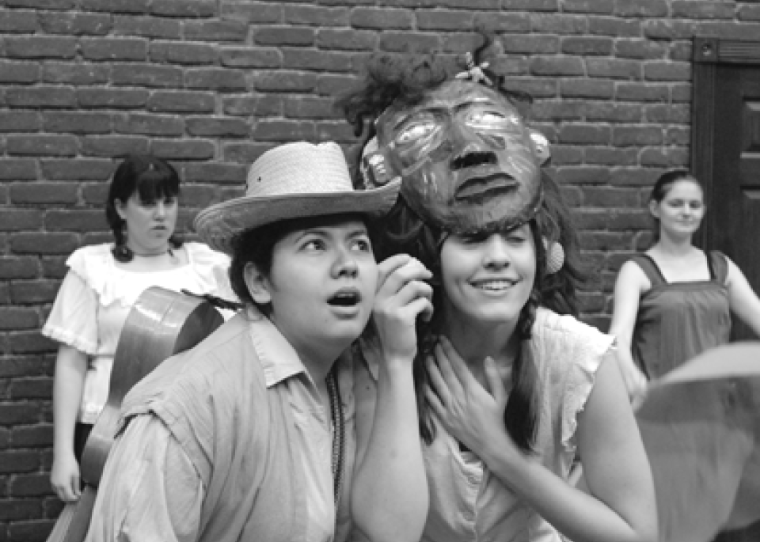
¡BOCÓN!
Santa Clara University Children’s Theatre Program Explores Immigration
“THEATRE…SPEAKS MORE THAN TO THE CONSCIOUS LEVEL,” SAYS GIULIANA CHION, AN ACTOR IN THE SANTA CLARA UNIVERSITY CHILDREN’S THEATRE PRODUCTION OF “¡BOCÓN!,” A PLAY DESIGNED TO SHARE WITH ELEMENTARY SCHOOL CHILDREN THE PLIGHT OF A YOUNG IMMIGRANT BOY FLEEING CENTRAL AMERICA.
Filled with humor, mysticism, and song, “¡BOCÓN!” (loosely translated as “loud mouth”), written by playwright Lisa Loomer, tells the story of twelve-year-old Miguel, a particularly loud and outspoken young boy, who loses his voice while fleeing a repressive regime somewhere in Central America. Traveling north to Los Angeles, he meets the mythological La Llorona. Through their friendship Miguel finds his voice and the courage to cross the border to a new life.
Started in the early 1980s, the Children’s Theatre Program was at first a summer program of the Department of Theatre and Dance at SCU. “We always choose shows that have something worth telling children,” says Barbara Murray, who serves as the program director as well as director of SCU’s musical theatre program, and an associate professor in costume design. “The choice of subject matter,” she says, “is couched in imaginary settings, and always based on real life issues children have to face: divorce, death of loved ones, conflict resolution, friendship, truth and honesty; and, in the case of ‘¡BOCÓN!’ a small boy losing his voice out of fear at the horror that is happening around him.”

The cast gathers at 11:50 a.m. on Tuesdays and Thursdays for rehearsal. Class begins this day with exercises to loosen up: stretching, shaking feet and shoulders, sometimes accompanied by vocalizations that sound like monks chanting. They move on to exercises for the tongue: “red leather, yellow leather.” They get props from the closet, and work on reading the play, blocking where they will stand. The process seems to be a collaborative one.
After rehearsal, I have a moment to talk with some of the actors about why they became involved. “I attended this same play when it came to my grade school about ten years ago,” shares one. “It had such a profound effect on me then that I just wanted to be part of sharing this story with other young grade school kids.”
“I feel strongly about using drama as a way of speaking to children,” says another. “It does not speak to the head but to the heart. You can get through to children who may not be able to hear the message in any other way.”
And another adds, “This play speaks personally to me. I had similar experiences as a child where things were happening to me that I could not talk about. Eventually I found my voice, and it changed my life. I am passionate about sharing this experience with children.”
“I am an immigrant myself,” says Chion, “so I can relate to what young immigrant children experience.” Immigrating to the United States, she earned an engineering degree, and then switched to study counseling.
In addition to the lessons offered by the play itself, Chion feels that the experience of live theatre is very important for the children who attend. “I am a counselor in two elementary schools,” she explains, and “it is scary to notice that kids spend most of their time in front of Internet or video games…. Children are missing a lot of human contact and human reality.
“I strongly believe that all the children need to be exposed to arts,” she adds. “Through this, they acquire skills to express themselves, to exercise the imagination, to play with limited materials, to produce something by themselves, to feel proud about their own creation."
“Santa Clara University has its focus in forming the whole person, and I strongly believe that art is a necessary element in the formation of a person,” she says.
The play’s message of courage and hope is relevant especially to immigrant children and to any child who is learning the many meanings of finding one’s own “voice.” It was performed on campus in the Fess Parker Theatre on Saturday April 5, 2008. It then went on the road to local elementary schools in April and May 2008.